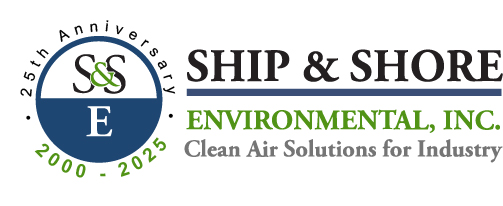
CASE STUDY – Advanced VOC Collection System with Optimized RTO for Flexographic Printing
November 19, 2025 8:30 amCASE STUDY: Advanced VOC Collection System with Optimized RTO for Flexographic Printing
November 19, 2025
Client Overview
A U.S. flexographic printing facility expanding production was experiencing rising VOC emissions from presses, dryers, and ink-mixing areas. Aging ductwork and inconsistent airflow reduced abatement efficiency, increased energy use, and added compliance pressure.
Ship & Shore Environmental was brought in to engineer a modern VOC collection system paired with a properly sized regenerative thermal oxidizer (RTO) to improve capture efficiency, lower operating cost, and make room for future press expansion.
Challenges
- Airflow imbalance between older and newer presses.
- Fugitive emissions from open press decks affecting compliance and indoor air quality.
- Inefficient RTO loading caused by fluctuating airflow and poor duct layout.
- Higher fan horsepower required to overcome restrictions in existing ductwork.
- Limited flexibility for future equipment additions.
Engineering Approach
Ship & Shore focused on the collection system first, ensuring the RTO could be sized for actual process needs rather than inflated airflow.
Key elements included:
- Permanent Total Enclosures (PTEs) around press decks for near-complete VOC capture.
- Redesigned ducting and airflow balancing across legacy and new presses.
- Cascading and recirculation strategies to reduce total CFM while maintaining capture efficiency.
- Modular duct routing that simplifies future press connections.
- Heat-recovery integration—such as condensing economizers—to reclaim energy and reduce fuel consumption.
- Automated control logic tied to press operation for steady capture and consistent RTO loading.
Solution Highlights
- 25,000 SCFM RTO designed to handle peak VOC loads after airflow optimization.
- Custom hoods and engineered ductwork for high-emission points.
- VFD-controlled fans for real-time airflow adjustment.
- Low-NOx burner technology for reduced secondary emissions.
Results
- Full compliance with EPA, state, and local VOC rules.
- Higher RTO destruction efficiency with stable airflow.
- Reduced operating cost through lower airflow demand and energy recovery.
- Near 100% VOC was captured in PTE controlled areas.
- Modular design ready for future presses with minimal system changes.
- Improved indoor air quality and safer working conditions.
Conclusion
This project shows how a precisely engineered VOC collection system enables the use of a smaller, more efficient RTO without sacrificing performance. With PTEs, balanced ducting, modular layouts, heat-recovery options, and smart controls, flexographic facilities can achieve strong VOC destruction, predictable compliance, and long-term operational savings.
📞 Contact us at +1 (562) 997-0233
📧 Email: service@shipandshore.com
Categorised in: Case Study & White Papers, News, News, VOC Abatement

